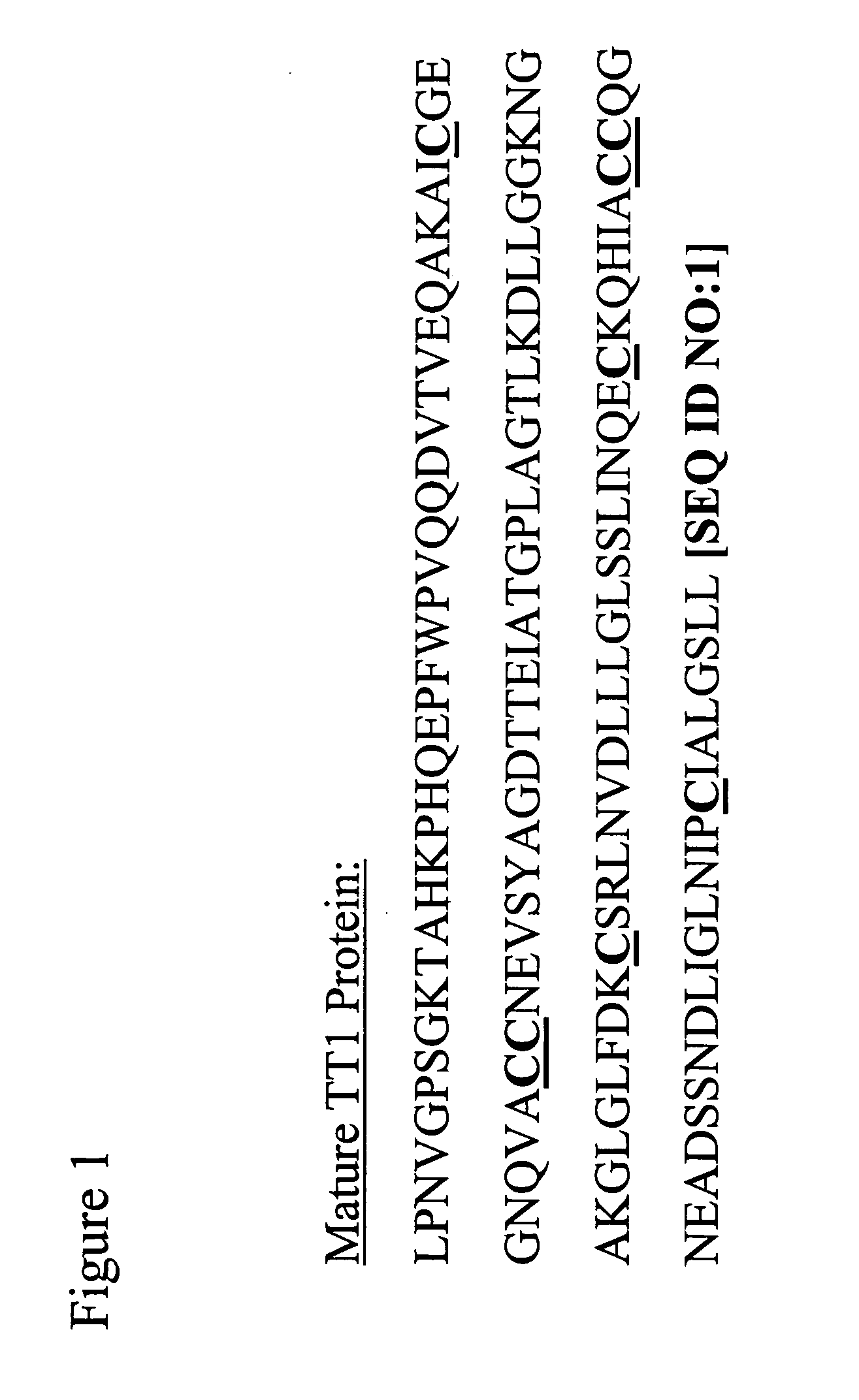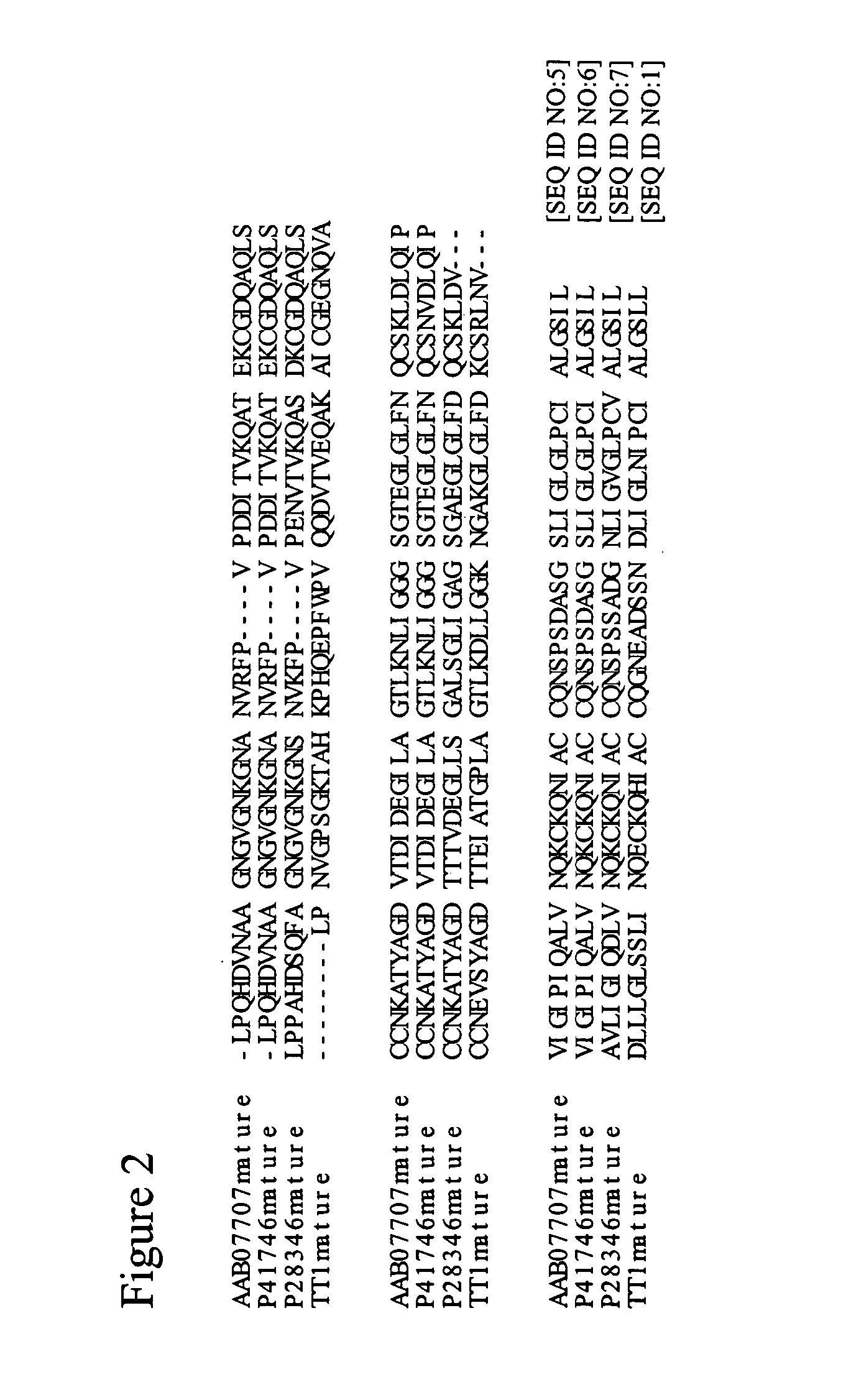Thermophilic hydrophobin proteins and applications for surface modification
a technology of hydrophobin proteins and surface modification, applied in the field of biotechnology, can solve the problems of insufficient amount of protein that can be obtained using this method of preparation for commercial applications
- Summary
- Abstract
- Description
- Claims
- Application Information
AI Technical Summary
Problems solved by technology
Method used
Image
Examples
example 1
Identification of Novel Hydrophobin from Talaromyces thermophilus
[0109] A cDNA clone encoding a hydrophobin protein was identified in a Dupont EST library of Talaromyces thermophilus. The Talaromyces thermophilus EST sequences were analyzed by conducting BLAST (Basic Local Alignment Search Tool; Altschul et al. (1993) J. Mol. Biol. 215:403-410; see also the explanation of the BLAST alogarithm on the world wide web site for the National Center for Biotechnology Information at the National Library of Medicine of the National Institutes of Health) searches for similarity to sequences contained in the BLAST “nr” database (comprising all non-redundant GenBank CDS translations, sequences derived from the 3-dimensional structure Brookhaven Protein Data Bank, the last major release of the SWISS-PROT protein sequence database, EMBL, and DDBJ databases). The cDNA sequences of the Talaromyces thermophilus library were analyzed for similarity to all publicly available DNA sequences contained i...
example 2
Partial Purification of TT1 from Fungal Expression Cultures
[0114] TT1 was expressed in a Trichoderma reesei expression system using a chimeric gene construction containing the following components, in the following order: [0115] 1) the promoter from the Trichoderma cbh1 (cellulase) gene [0116] 2) the polynucleotide encoding the secretion signal peptide of the cbh1 precursor protein [0117] 3) the polynucleotide encoding the mature TT1 protein with no translation stop codon [0118] 4) a polynucleotide encoding the Flag octapeptide and a His (6×) tag, incorporated to facilitate screening of fungal transformants and to aid in purification, followed by a translation stop codon [0119] 5) the transcription termination sequence from the cbh1 gene Expression of the cbh1 promoter was induced by growth on cellulose-containing medium for 5-6 days. Mycelia and culture medium were separated by centrifugation. The culture medium, in samples of 100 ml, was mixed at maximum speed for 2 min using the...
example 3
TT1 Coating of Films and Surfaces
[0120] For all TT1 coating studies, lyophilized powder of TT1 protein sample was suspended in a small volume of trifluoroacetic acid. The solution was evaporated to dryness and then resuspended and diluted in degassed water to an estimated concentration of 16 μg / ml. This concentration was based on the estimate that the TT1 protein sample contained TT1 as 10% of the total protein in the sample, as determined by visual inspection of a coomasie stained sample that was separated by gel electrophoresis. The total protein concentration was determined using the Bicinchoninic Acid Protein Assay Kit (Sigma, procedure No. TPRO-562).
[0121] The following polymer sheets and films were used for coating:
Fluoropolymers:
[0122] Teflon® PFA 1000LP: a copolymer of tetrafluoroethylene / -perfluoro(propyl vinyl ether), with a thickness of 250 μm (DuPont Company, Wilmington, Del.).
[0123] Teflon® FEP 1000A: a copolymer of tetrafluoroethylene and hexafluoropropylene, wit...
PUM
| Property | Measurement | Unit |
|---|---|---|
| water contact angle | aaaaa | aaaaa |
| water contact angle | aaaaa | aaaaa |
| temperature | aaaaa | aaaaa |
Abstract
Description
Claims
Application Information
 Login to View More
Login to View More - R&D
- Intellectual Property
- Life Sciences
- Materials
- Tech Scout
- Unparalleled Data Quality
- Higher Quality Content
- 60% Fewer Hallucinations
Browse by: Latest US Patents, China's latest patents, Technical Efficacy Thesaurus, Application Domain, Technology Topic, Popular Technical Reports.
© 2025 PatSnap. All rights reserved.Legal|Privacy policy|Modern Slavery Act Transparency Statement|Sitemap|About US| Contact US: help@patsnap.com



